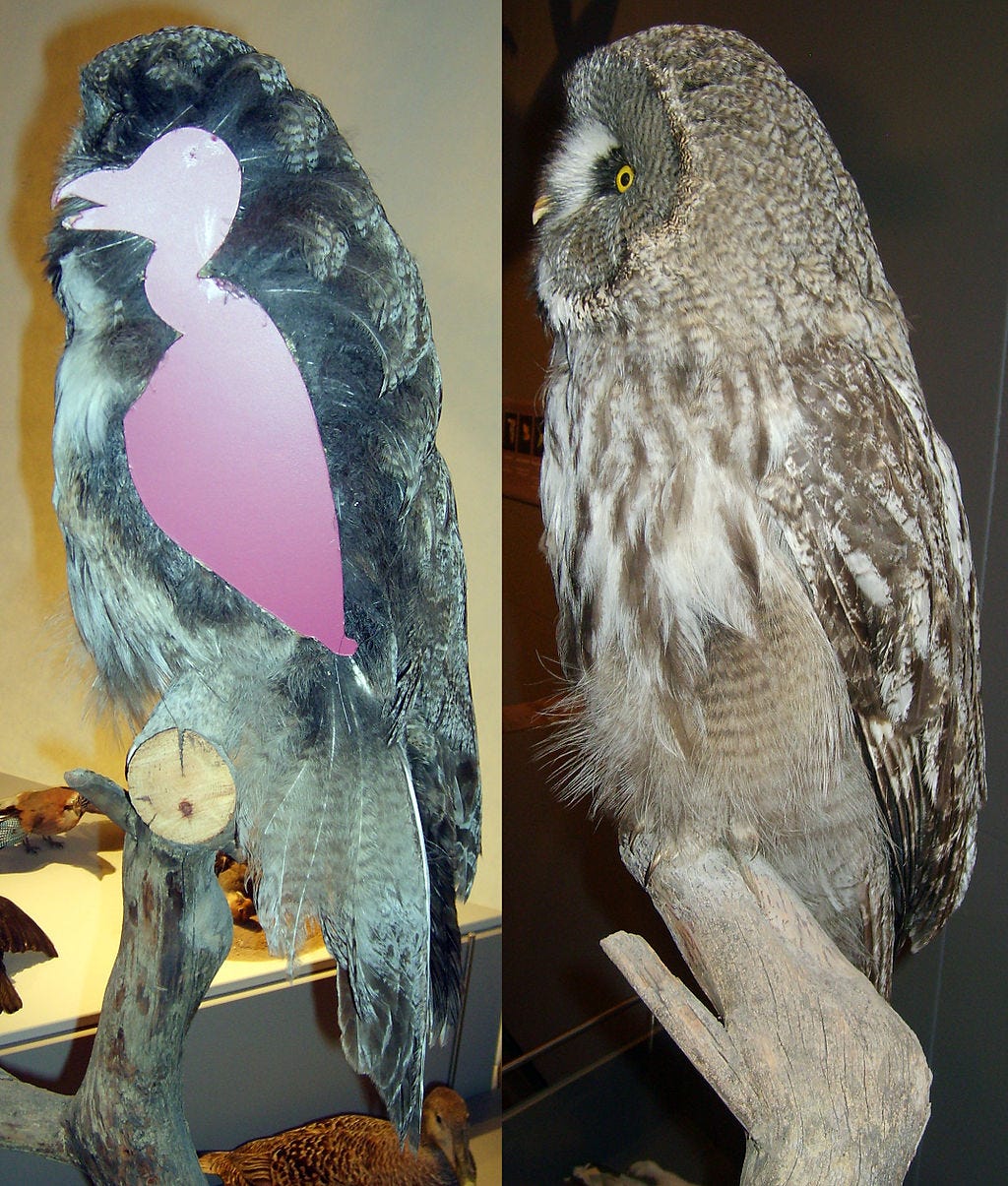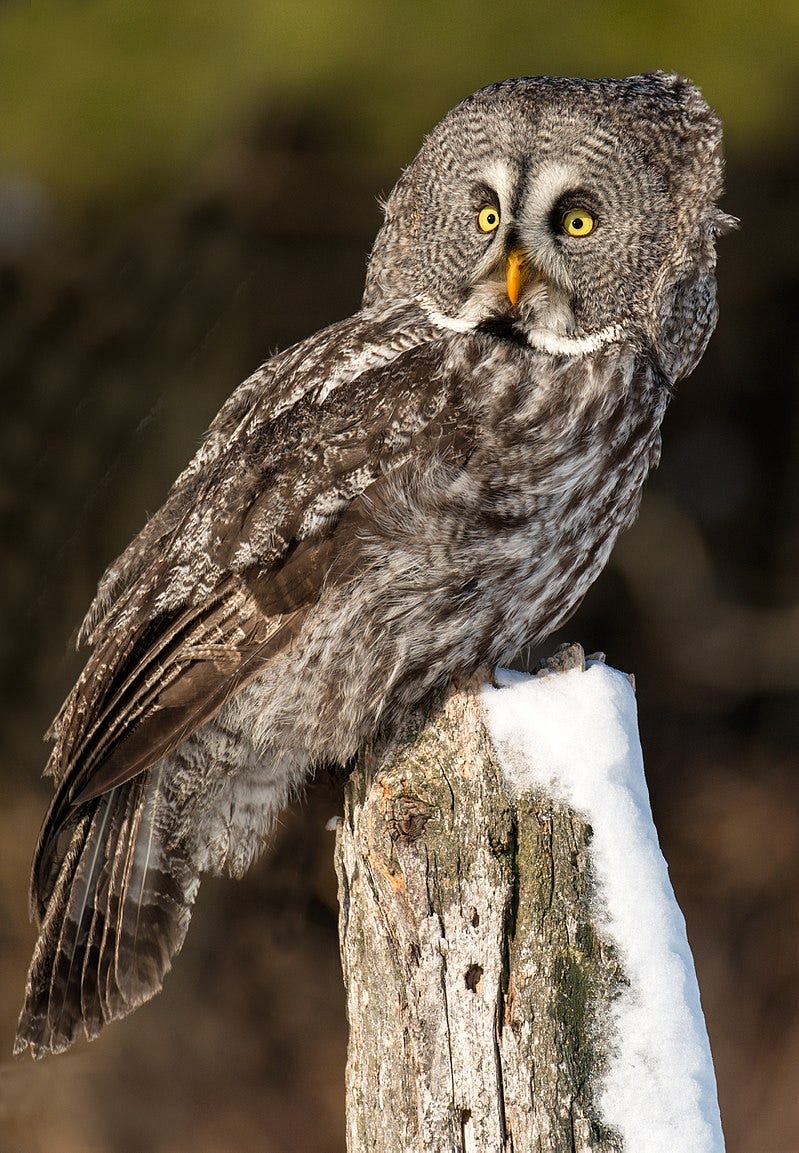The Phantom of the North's Secret to Slaying
Scientists have discovered how one of the world's largest and sneakiest owls makes a living.
Today’s post is brought to you by Elizabethtown College in Elizabethtown, Pennsylvania, where I’ve been speaking with students about science writing as a career. (Also deer antlers, opossum jellybean-babies, and hairy-bellied tarantulas, because you know how I do.)
I’m always grateful for these kinds of opportunities, not only because it’s good to see how my writing resonates (or not) with a very specific demographic—college kids who may or may not only be in attendance to get a little extra credit. I’m kidding, but I also remember what it was like being an undergrad going to speakers you wouldn’t have otherwise because it was an assignment. There are also, of course, plenty of students either in the writing or science departments that are curious about what a science writer does and how to become one and, you know, whether you can actually make any money doing so. Which are all good questions to have!
Anyway, I think it’s good to get young people thinking about this thing we do as a career option that both pays bills, educates the public, and lets you spend afternoons chatting about lightning bug butts and staring at tiny jellyfish relatives known as Hydra which have the very interesting distinction of being kinda, sorta immortal. More on that in a future post!
Because today, I’d like to talk to you about owls.

The Phantom of the North
Everybody knows at least a little bit about owls. A lot of them hoot. They tend to hunt at night. They regurgitate bones and fur in neat little pellets that look like lint balls which you may or may not have had to pry apart in high school science class.
But today’s tale is about a total stunner of an owl known as the Phantom of the North.
More officially known as the great gray owl (Strix nebulosa), this species is native to the Northern Hemisphere, where it haunts the forests of North America, Europe, and Asia in search of voles.
What is a vole, by the way? This is a vole.

At 33 inches long (84 cm), most consider the great gray to be the largest species of owl on the planet, at least when measuring by length. Go by weight though and other species are larger, because beneath their feathery floof, great gray owls are hilariously petite.
I mean, try not to laugh at this representation of what a great gray owl would look like naked.

Now then, great grays also have the most impressive facial disk of any owl, which is important for the reason I’m talking to you about this species today.
In winter, when their worlds are covered in snow and ice, and furry little snacks are nowhere to be seen, the great gray owl has a trick up its sleeve.
Not only can the raptors hear rodents scurrying below the ice, but they can zero in on those sounds by hovering above them and then plunging through the crust to extract their dinner. What’s more, they can perform this feat in snow that is up to 20 inches (50 cm) thick!
The performance is even more mind-blowing when you consider that snow is kind of a weird structure. According to a recent study in which scientists Christopher Clark, James Duncan, and Robert Dougherty looked at all this in great detail, “Snow is a complex matrix of an ice skeleton and open-air pores. It has highly variable material properties, especially porosity and density. These material properties change with time, beginning as soon as a snowflake settles and chemically bonds with the snowpack.”
And all of this can be dramatically altered by things like wind, which both compacts snow and breaks it up and forms drifts, as well as new snow falling on top of old snow. Snow also absorbs sound and can even displace it, creating an audible mirage that could confuse a predator listening in on the sounds happening below.
So how the actual cuss do great gray owls navigate this landscape? Well, after sinking some waterproof microphones in the snow and investigating a bunch of variables that are above most of our paygrades, the scientists believe this is how it works:
A great gray owl sits on its perch, listening.

From up to 164 feet (or 50 meters) away, the owl hears a barely audible scritch. Because it probably can’t tell exactly where the sound is coming from, the owl will then soar in, adjusting its course as it flies and sounds are picked up by its ears and probably also captured by its enormous, moon-shaped facial disk, which seems particularly adapted to picking up low-frequency sounds and directing them to the owl’s hidden ears.
As soon as the owl determines it’s directly above the vole, it pulls up in its flight and then begins to hover using the most quiet-adapted feathers known in the Animal Kingdom. In fact, the scientists in the paper refer to the species as a “quiet flight extremist”, and suggest that the purpose of being silent is two-fold.
For one, being quiet keeps the prey animal unaware of the blood-thirsty phantom now hovering just inches above it. And two, being quiet probably allows the bird to hear its target better.
In any event, while the great gray hovers like a hummingbird, it is also pinpointing the exact location of the rodent below—because the shortest path through the snow, and thus the direction least likely to create a sound mirage, is straight up and down.
Once the target is locked, the owl extends its talons and plunges through the crust until it feels something warm and soft and vole-y.
When it flaps away into the night, it has a fistful of mammal for the trouble. The only evidence the predator was ever there is a small pockmark in the snow.
Who Cares About Owls?
So, why am I telling you all of this? The most obvious reason is because it’s awesome. But if that’s actually not obvious to you, well, I’ll just say that it’s absolutely fascinating to me that Clark, Duncan, and Dougherty were able to take a rather unknowable thing—what is going on inside a great gray owl’s head when it decides to hunt voles hidden beneath the snow—and make it surprisingly knowable by exhaustively studying as many variables as they could get their hands upon.
What’s more, the study provides a frankly bonkers insight into the result of untold millennia of evolution. The owl doesn’t know what it’s doing or why, of course. It doesn’t think about why its face is shaped the way it is or how its feathers make it sound, or more accurately, how its feathers make it sound like nothing at all.
The owl just is. The owl just does.
And the more owls that just are and just do, the more those genes get passed on to the next generation, and gradually, over time scales that make our minds melt, a descendant of the dinosaur is molded into a highly adapted night ghost that strikes at the invisible and then disappears without a trace.
It’s a saga that has played out a bajillion times outside of our line of sight, but now, thanks to some super smart scientists and a lot of bit of curiosity, we have a window into how the vole sausage is made.





